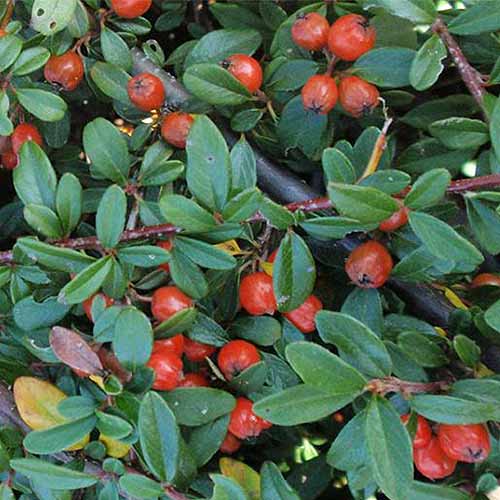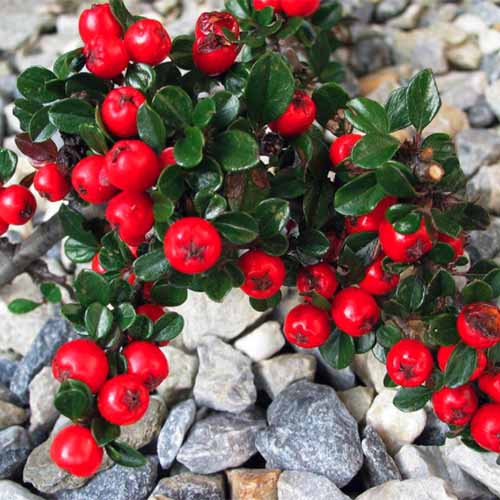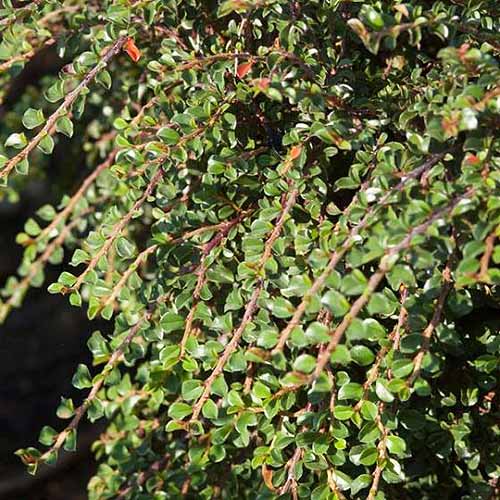Semi-evergreen types will remain evergreen in warmer locations, and drop their leaves in cooler growing zones.
In our guide to growing cotoneaster, you’ll learn that they’re very easy to care for – a little spring pruning for shape if needed, and that’s about it for maintenance!
Sound like a plant-and-forget shrub your garden needs?
Then join us now for a look at 21 of the best cotoneaster varieties for ground covers, hedges, and more!
Here they are:
21 of the Best Cotoneaster Varieties for Your Garden
It should be noted that some species have escaped garden cultivation and are considered invasive in certain coastal areas in North America such as British Columbia, California, the Great Lakes states, Hawaii, and the Pacific Northwest, as well as in parts of Australia, New Zealand, and western Europe.
You may wish to check with your local extension office or the USDA invasive plants list before planting, to ensure that your chosen variety is not considered invasive in your area.
1. Bearberry
Bearberry, C. dammeri, has low, trailing stems that grow up to 10 feet long, with a height that ranges from six to 24 inches.
An evergreen, the ovate leaves are deep green and glossy, turning reddish-purple in the fall. The stems are covered with a showy display of single white flowers in late spring followed by bright red berries through fall and winter.
Bearberry cotoneaster is a versatile shrub that can be used for borders, ground covers, atop retaining walls, or for soil stabilization. Hardy in Zones 5 to 9, plants are semi-evergreen in colder areas.
‘Coral Beauty’ features lovely, coral pink berries and reaches mature dimensions of 18 to 24 inches tall with a spread of five to six feet.
You can find plants in #1 containers available at Nature Hills Nursery.
2. Black-Fruited
The black-fruited C. melanocarpus is a mid-sized shrub with a rounded form and is extremely drought tolerant once established.


Abundant panicles of pinky-white flowers appear in late spring and pomes emerge as deep orange or red, then ripen to a rich, purplish black.
The glossy, ovate leaves shine in blazing shades of orange, red, and yellow in fall.
Suitable for cultivation in Zones 3 to 7, black-fruited cotoneaster is a deciduous shrub used for borders, hedges, and bank stability. It has a height and spread of four to eight feet.
3. Cranberry
Cranberry cotoneaster, C. apiculatus, is low and sprawling with fine-textured foliage and long, trailing stems. Plants grow up to 18 inches tall and spread three to six feet.
Pink blooms appear in spring, then a profusion of bright red berries in fall, with round, glossy leaves that turn red to burgundy in autumn.
This deciduous species is a beautiful choice for a low barrier, ground cover, rockeries, or for slope and bank stabilization. Plants are suitable for cultivation in Zones 4 to 7.
You can find plants in #1 and #3 containers available at Nature Hills Nursery.
4. Creeping
C. adpressus, aka creeping cotoneaster, are compact deciduous plants with trailing stems that reach up to six feet long with a height of only 12 inches.
Pinky red flowers are followed by dark red berries and deep burgundy fall colors. This species is hardy in Zones 4 to 7 and is highly drought tolerant once established.
Most effective when used for borders, ground covers, and in rockeries. It’s also a popular choice for topiary and bonsai.
‘Tom Thumb’ is a dense, dwarf cultivar with tiny leaves and smaller-than-average fruit.
Plants are available in one-gallon containers at Nature Hills Nursery.
5. European
A good choice for regions with cool summers, the deciduous European species, C. integerrimus, has a multi-stemmed, upright growth of five to eight feet with a similar spread.


In late spring, the stems are covered with attractive, small cream flowers and dense foliage, then an abundance of rose-colored berries.





